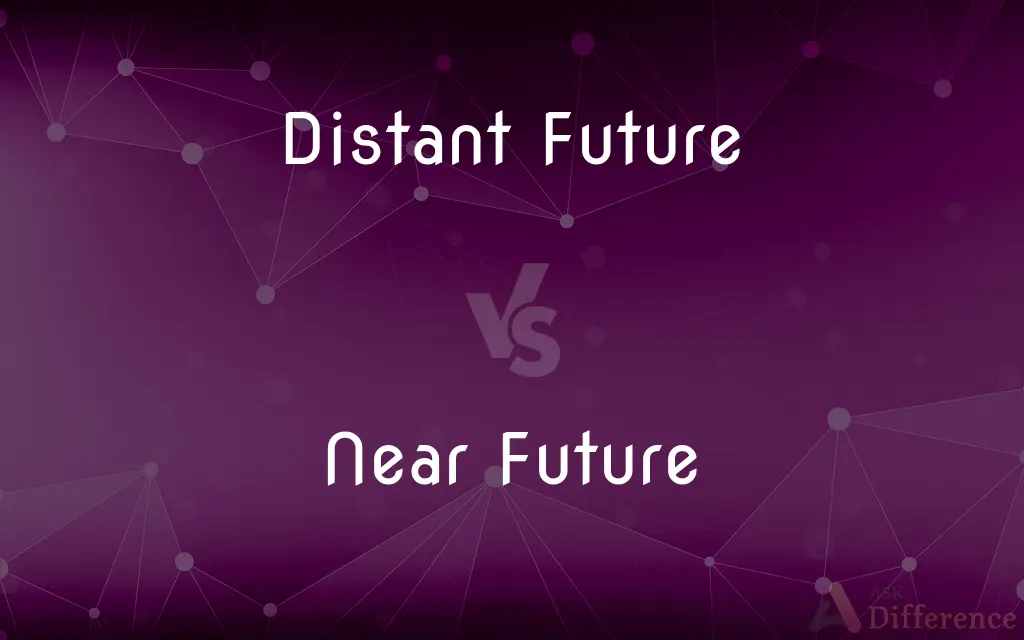Distant Future vs. Near Future — What's the Difference?
By Tayyaba Rehman — Published on November 14, 2023
"Distant Future" refers to a time far ahead, often undefined, while "Near Future" indicates a time relatively close to the present, usually foreseeable.

Difference Between Distant Future and Near Future
Table of Contents
ADVERTISEMENT
Key Differences
The term "Distant Future" conveys a time frame that is considerably far from the present moment, often surrounded by uncertainty or speculation. In contrast, the "Near Future" is a period that will soon follow the current time, and it's often more predictable or expected.
When discussing events or developments, those set in the "Distant Future" may involve extensive changes, advancements, or evolutions, due to the longer time span involved. The "Near Future," on the other hand, would likely see incremental changes or immediate next steps based on the present state of affairs.
In literature and media, the "Distant Future" often serves as a backdrop for speculative or science fiction, imagining radically different societies or technologies. In contrast, stories set in the "Near Future" might only exhibit subtle differences from the present, reflecting more immediate concerns or trends.
Linguistically, both "Distant Future" and "Near Future" serve as nominal phrases, but they cater to different temporal scopes. While "Distant Future" implies a long-term perspective, "Near Future" is focused on the short term.
Emotionally, "Distant Future" can evoke feelings of wonder, uncertainty, or even apprehension due to its vast possibilities. The "Near Future," given its proximity, often brings forth anticipation, preparation, or immediate curiosity.
ADVERTISEMENT
Comparison Chart
Temporal Scope
Long-term perspective
Short-term perspective
Predictability
Often uncertain or speculative
More foreseeable and defined
Typical Use
Speculative scenarios
Immediate plans or changes
Emotional Connotation
Wonder, uncertainty
Anticipation, immediacy
Examples in Literature
Radical futuristic societies
Subtle shifts from the current state
Compare with Definitions
Distant Future
An undefined and speculative time ahead.
The implications of this technology will be clearer in the distant future.
Near Future
A time period soon following the present.
We plan to launch the product in the near future.
Distant Future
A long-term projection or forecast.
Sustainability efforts today affect the health of our planet in the distant future.
Near Future
An era prompting immediate actions or decisions.
With the asteroid approaching Earth, decisions need to be made for the near future.
Distant Future
A time period far from the present.
The colonization of other galaxies remains in the distant future.
Near Future
A period characterized by events or conditions closely related to current ones.
The world can expect slight economic improvements in the near future.
Distant Future
A time often characterized by significant change or evolution.
In the distant future, humanity might achieve true global unity.
Near Future
A foreseeable and upcoming time frame.
Technological advancements in the near future will enhance virtual reality experiences.
Distant Future
An era beyond immediate concerns or plans.
While flying cars are exciting, their mass adoption is a matter for the distant future.
Near Future
An imminent phase or stage.
Changes to the policy will take effect in the near future.
Common Curiosities
Are "Distant Future" and "Near Future" relative terms?
Yes, their meanings can change based on the time frame being discussed.
Is "Distant Future" always a specific number of years away?
No, "Distant Future" is often undefined and can vary based on context.
Does "Distant Future" always mean uncertainty?
Not always, but it often carries a sense of speculation due to its longer horizon.
Can "Near Future" evoke urgency?
Yes, since it implies events or changes happening soon.
Can "Near Future" be used in planning?
Yes, it's often used for short-term planning or immediate next steps.
Can "Near Future" refer to events next week?
Yes, "Near Future" can indicate events in the coming days to a few years.
How does culture affect perceptions of "Distant Future" and "Near Future"?
Cultural values can influence how societies view and prioritize the future.
Is "Distant Future" synonymous with "far future"?
Yes, both terms refer to a time considerably ahead.
Can "Near Future" be subjective?
Yes, what's near for one person or industry might be distant for another.
Is "Distant Future" commonly used in fiction?
Yes, especially in speculative or science fiction genres.
Can "Near Future" discuss technological changes?
Yes, often about advancements expected in a few years.
How far can "Distant Future" be?
It can range from several decades to millennia, depending on the context.
Which term, "Distant Future" or "Near Future," is more common in daily conversation?
"Near Future" is more common, as people often discuss upcoming events or plans.
Do "Distant Future" and "Near Future" always pertain to time?
Primarily, but they can also metaphorically describe relative stages or conditions.
Is the "Near Future" always optimistic?
Not necessarily, it can convey both positive and negative expectations.
Share Your Discovery

Previous Comparison
Part With vs. Part From
Next Comparison
Snow vs. ShineAuthor Spotlight
Written by
Tayyaba RehmanTayyaba Rehman is a distinguished writer, currently serving as a primary contributor to askdifference.com. As a researcher in semantics and etymology, Tayyaba's passion for the complexity of languages and their distinctions has found a perfect home on the platform. Tayyaba delves into the intricacies of language, distinguishing between commonly confused words and phrases, thereby providing clarity for readers worldwide.











































